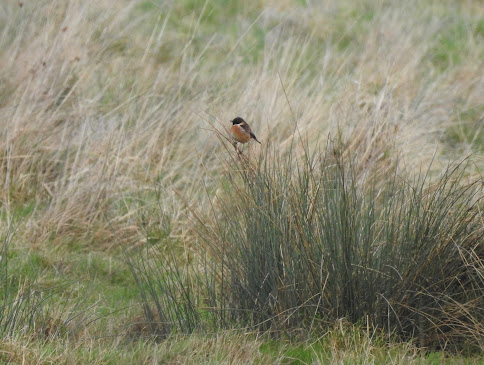If it hadn't been for the discovery of the White-fronted Goose yesterday I would not have been back at Morton Bagot this morning, and certainly not in the field an hour before dawn. But the chance of getting the goose on both the 2023 and 2024 year-lists proved irresistible.
There was just one problem. The goose had gone. I had blithely imagined that geese will have roosted on the flashes as they do in September. They hadn't. My back up plan was that it would be early enough to see Owls. I saw none.
However, before Dave arrived at our usual rendezvous time I had one little slice of good fortune. While I lurked at the edge of the tiny reed bed at the dragonfly pools I heard a Kingfisher, and because I was obscured by the reeds it landed in a bush right in front of me.
 |
| Kingfisher |
Bearing in mind that in most previous years there have been no Kingfishers at Morton Bagot until about July, this was quite a coup.
Dave arrived and we set off on the familiar circuit. As it was the first day of the year, every species took on a renewed significance as the list grew. Having said that, we made a conscious decision not to disturb the Snipe in the scrape field as I gathered Tony had been in the marsh yesterday and had recorded five Jack Snipe. We felt they needed a breather.
There was renewed optimism about the Goose situation as I had seen over thirty Greylag Geese flying in from the south. Sadly this was misplaced and we counted just the same 37 Greylags as yesterday. Also absent were the large numbers of thrushes seen previously. We saw barely 20 each of Fieldfares and Redwings. On the plus side we saw the Stonechat in the scrape field and then added two more in the flash field.
 |
| Male Stonechat in the flash field |
On my early morning visit I had counted 40 Teal on the nearest flash, but now there were about half as many visible. Two Lapwings stood at the edge of the furthest flash, and a highlight came as a Green Sandpiper dropped onto the back edge of the nearest.
 |
| Green Sandpiper |
Dave suggested another scan of the geese so we retreated back up the slope to give it one more go. Same result, except that we heard two of the less expected species. Firstly a Yellowhammer called several times as it flew over us, visible only as a distant dot, and then a squeal from the rushes surrounding the nearest flash was enough to add Water Rail to the year-list (and this time we both heard it).
Our final tally was a solid 51 species (only 50 for me because I missed some Red-legged Partridges Dave had flushed on the walk back).
However I added a Jay to my list as I drove home.
You can't beat the first day of the year.
No comments:
Post a Comment